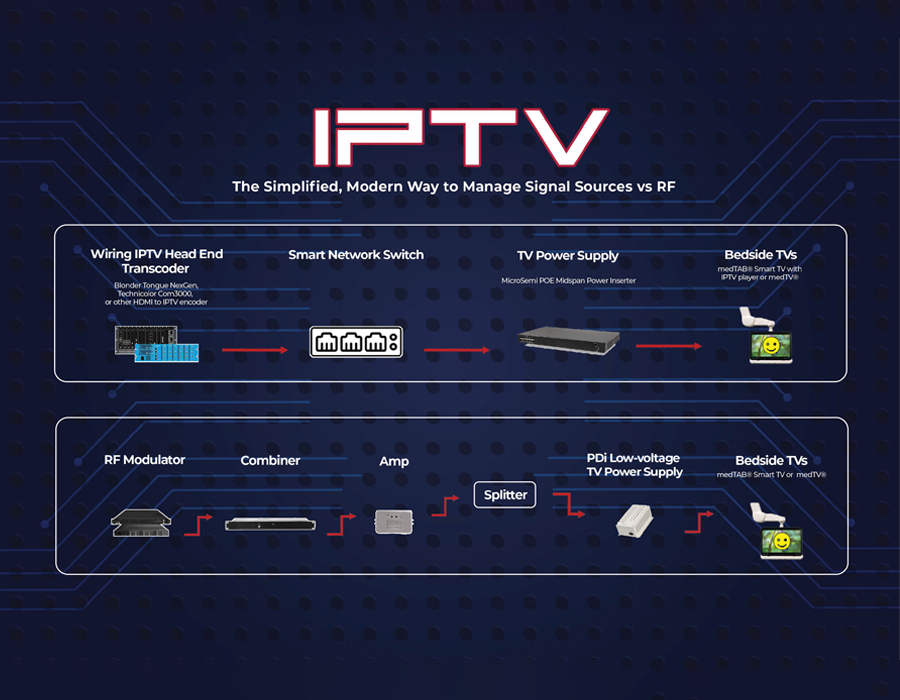The Benefits of IPTV in Healthcare Settings
IPTV is emerging as the next evolution in TV distribution in healthcare facilities. This modern approach brings significant time and cost savings to...

Having worked at PDi as the Service Manager for over 13 years, it’s been a long time since we began discussing IPTV, Internet Protocol TV, as a real option for healthcare facilities. We have reached that point now where IPTV is within reach for any facility. With some cost savings and a better patient experience, this makes IPTV an attractive option in healthcare facilities today to broadcast what matters most.
PDi has long been considered experts in RF distribution systems for healthcare. IPTV is a different animal, and it has different rules. IPTV also has a lot of advantages. Don’t rule it out because it’s different. Sometimes new and different is better.
Check out our 3-part Podcast Series on IPTV.
The basic premise of IPTV, Internet Protocol TV, is that delivering the TV signal over ethernet provides a consistent HD signal over a longer distance at a cheaper labor and material cost. Let’s break that down. Ethernet is less expensive, easier to work with and can be run longer distances than Coax. It also allows for internet access over the same cable. Power over Ethernet (POE) is available as well, which provides power, TV signal, and internet connection over one CAT6a cable.
For installers, IPTV benefits include shorter install times and less expensive materials. Ethernet cable is lighter, easier to bend in corners, and can run much longer distances.
The ability to support the TV headend remotely is a great benefit for the facility and for the installer. A few years ago, facilities staff wouldn’t consider allowing remote access to a hospital IT network. However, today many healthcare facilities are in the process of having upgrades to their networks to support high speed data and ensure data security. It is a benefit to healthcare facilities staff to know that a trusted partner like PDi can jump online and troubleshoot any issues remotely.
The footprint of an IPTV system at the headend is tiny compared to the space an old analog system took up. These days the hardware takes 3-6 RU in a rack and the cooling requirements are easier to support. Recently, we disassembled a headend in a facility with 68 channels (68 channel modulators) all analog with an H25 DIRECTV® receiver for each channel. The racks took up most of the closet. The new COM3000 DIRECTV headend system took up one shelf in the rack and created a much cooler and spacious environment. The power consumption is much less also.
Thinking of upgrading to IPTV in your hospital? Talk to PDi first. IPTV may be for you
The only times I wouldn’t consider it for an installation are (1) if there are TVs other than PDi sets in the mix that may or may not work with an IPTV stream, or (2) if an infrastructure already exists with a high-quality solid copper core coax that can provide strong TV signal and power for PDi arm mounted TVs.
Lastly, with IPTV, the TV signal can come into the building as Fiber or QAM and be distributed over CAT6a. It will work with most cable companies and satellite companies.
Give us a call to discuss your options if you are looking to upgrade to IPTV or any part of your patient TV experience. At PDi, we are with you every step of the way.

IPTV is emerging as the next evolution in TV distribution in healthcare facilities. This modern approach brings significant time and cost savings to...

IPTV, Internet Protocol TV,remains a prominent topic in the healthcare industry, steadily gaining momentum as a game-changer. In part one of our IPTV...

Over the course of the last few months, many healthcare facilities have been notified that their cable companies will no longer provide traditional...